Effective root systems for living walls require lightweight, well-draining growing media that balances moisture retention and aeration. You’ll need to maintain pH between 6-7 and incorporate organic matter to enhance microbial activity. Install recirculating irrigation systems that adjust for seasonal changes, consuming 2.5-9 L/m² annually. Select shallow-rooted plant species with appropriate spacing to prevent entanglement. Monitor root health regularly for signs of rot or nutrient deficiencies. Discover how proper modular design can transform your vertical garden’s longevity and importance.
What Makes Effective Root Systems For Living Walls?
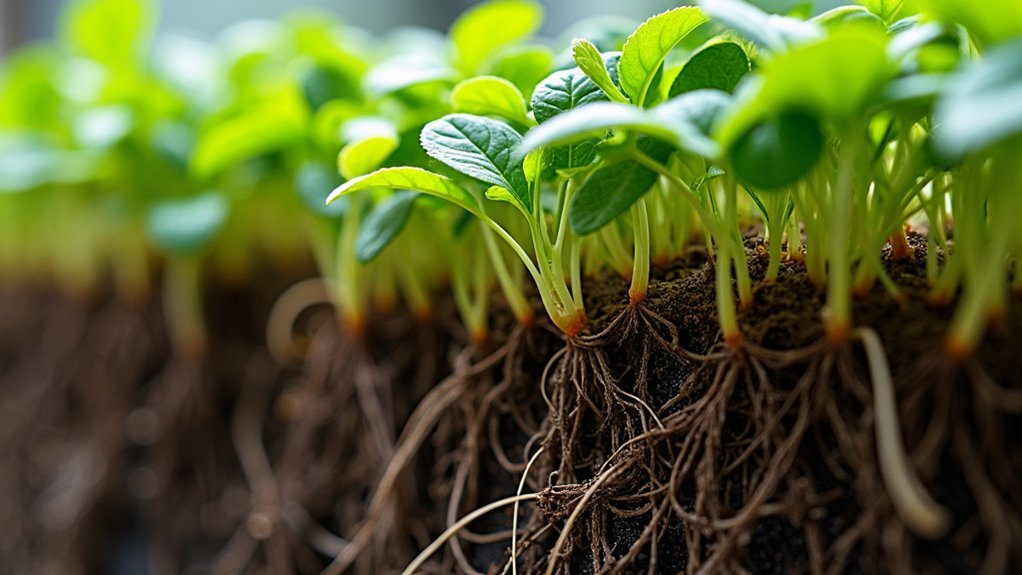
When creating a living wall, understanding the fundamentals of effective root systems is critical to long-term success. Your vertical garden depends on lightweight, well-draining growing mediums that balance moisture retention with proper aeration to support healthy root development.
Choose plant species strategically—shallow-rooted varieties like succulents and ferns thrive in vertical gardens where soil depth is limited. They’ll adapt more readily to your living wall’s constraints while maintaining vigor.
Your irrigation systems must deliver precise amounts of water—too much creates oxygen-deprived soil that suffocates roots, while too little causes dehydration and stress.
Design your wall with adequate space between modules to prevent root entanglement and allow for expansion. Remember to monitor root health regularly, checking for signs of pests or disease that could compromise your living wall’s stability.
The Science Behind Root Development in Vertical Gardens
The ideal root structure for vertical gardens depends on your substrate’s ability to balance aeration with moisture retention.
You’ll find that roots develop most effectively when they’re neither waterlogged nor dehydrated, as demonstrated in the Fytotextile® system’s improved water management capabilities.
Your monitoring efforts should focus on maintaining this critical balance through appropriate irrigation schedules, ensuring white, vigorous roots that efficiently exchange gases and absorb nutrients.
Root Structure Fundamentals
Healthy root systems form the invisible foundation of successful living walls, anchoring plants while performing the critical functions of nutrient absorption and water uptake. In vertical gardening, your plants’ roots need adequate space to develop properly despite limited soil volumes.
The growing medium you select directly impacts root health—lighter substrates promote better aeration and drainage, reducing root rot risks while supporting ideal development.
| Root Need | Challenge in Living Walls | Solution |
|---|---|---|
| Space | Limited soil volume | Perforated panels |
| Aeration | Compaction risk | Lightweight media |
| Moisture | Desiccation | Specialized irrigation |
| Nutrients | Depletion | Regular fertilization |
You’ll need to monitor root systems regularly, as they can become stressed or compacted in vertical environments. Incorporating perforated layers enhances root aeration and promotes healthier structures by preventing waterlogging while facilitating essential gas exchange.
Moisture-Retention Balance
Achieving ideal root development in vertical gardens depends fundamentally on striking the perfect moisture-retention balance within your growing medium.
Too much water suffocates roots and impedes gas exchange, while insufficient moisture stresses plants and stunts growth.
Modern systems like Fytotextile 3 and 4 demonstrate this principle effectively, with water retention improvements of 2.9 and 5.8 times over earlier versions—directly supporting healthier root systems.
Your living wall’s annual water consumption will range from 2.5 to 9 L m-2, varying by plant species and environmental conditions.
Effective irrigation management involves selecting materials that optimize water storage while minimizing wastage.
Research shows that precise irrigation scheduling maintains adequate moisture levels for robust root development while reducing overall water usage, especially in warm climates where consumption tends to increase.
Key Components of a Sustainable Living Wall Root Structure
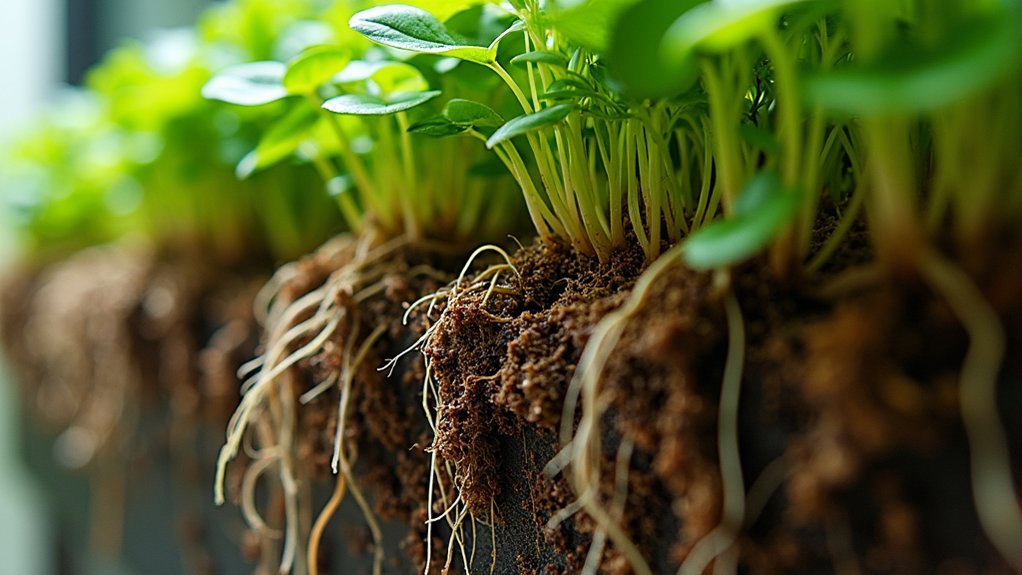
For sustainable living walls to thrive long-term, proper root structure must be carefully engineered with several interdependent components.
You’ll need to prioritize a well-structured substrate that balances aeration and drainage, allowing roots to breathe while accessing moisture. This foundation supports healthy root systems that can establish themselves even in vertical configurations.
Thoughtful plant species selection guarantees compatibility with your living wall’s confined growing environment. Choose plants with root structures that won’t compete excessively or outgrow their allocated space.
Plant selection is the cornerstone of living wall success—choose varieties with cooperative root systems suited for vertical constraints.
Complement these choices with efficient irrigation systems that deliver consistent moisture without causing waterlogging or drought stress.
Remember that lightweight, moisture-retentive materials in your substrate will prevent excessive weight while maintaining adequate water availability for your plants’ roots throughout vertical growing zones.
Optimal Growing Media for Strong Root Establishment
When selecting substrates for your living wall, you’ll need to balance weight considerations with materials that promote robust root development, such as lightweight mineral aggregates mixed with organic components.
You must guarantee your growing media provides adequate aeration while maintaining proper moisture retention capabilities, as demonstrated by advanced Fytotextile systems that can hold considerably more water than conventional options.
The ideal growing medium creates pore spaces for oxygen circulation while preventing waterlogging, allowing roots to establish quickly and access nutrients efficiently.
Substrate Selection Fundamentals
The foundation of successful living walls lies in selecting the right substrate, which directly impacts how well roots establish and thrive. When choosing your substrate, aim for lightweight materials like expanded clay, perlite, or coconut coir that won’t overburden the wall structure while providing optimal root systems support.
Your substrate selection should balance three critical factors: aeration, drainage, and moisture retention. A quality medium maintains a pH between 6 and 7, ensuring nutrients remain available to developing roots.
You’ll want to incorporate some organic matter, such as compost, to enhance microbial activity and nutrient content.
Remember that proper substrate formulation prevents water stress by retaining enough moisture while allowing excess water to drain away, protecting roots from rot and creating ideal conditions for robust growth.
Aeration-Moisture Balance Essentials
Achieving the perfect balance between aeration and moisture retention stands as the cornerstone of developing robust root systems in living walls.
You’ll need lightweight, well-draining substrates that prevent waterlogging while maintaining adequate moisture for root development.
Systems like Fytotextile® demonstrate how optimized materials markedly enhance both water retention and aeration, directly improving root establishment.
When designing your living wall, incorporate organic materials to boost nutrient availability and support beneficial microbes that strengthen root systems.
Remember to monitor moisture levels consistently, as both excess water and drought conditions will compromise root health.
The ideal growing medium creates pockets of air while retaining enough moisture, preventing root suffocation while ensuring constant hydration.
This delicate balance ultimately determines whether your living wall thrives with strong, extensive root systems or struggles to establish.
Water Management Strategies for Healthy Root Systems
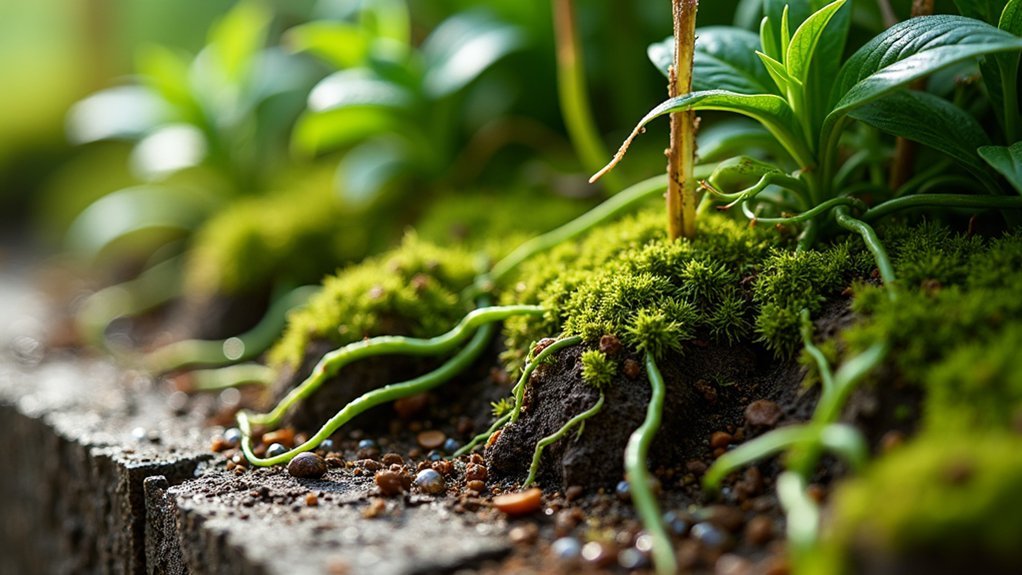
Proper water management stands as the cornerstone of developing robust root systems in living walls.
You’ll achieve peak root health by implementing efficient irrigation systems that balance moisture without drowning your plants. The Fytotextile® system demonstrates how improved materials can retain water 2.9 to 5.8 times more effectively, creating ideal conditions for root development.
To enhance your living wall’s water management:
- Schedule irrigation cycles strategically, adjusting for seasonal changes to maintain 2.5-9 L/m² annual consumption rates.
- Install recirculating systems to capture and reuse drainage water, reducing waste while maintaining consistent moisture.
- Select appropriate growing media that balances water retention with proper aeration to prevent oxygen starvation at the root zone.
These practices guarantee your living wall develops strong, resilient root systems while conserving water resources.
Nutrient Delivery Systems That Support Root Growth
You’ll find that modern nutrient delivery systems for living walls rely heavily on water circulation techniques that transport essential elements directly to the roots.
When selecting substrate materials, consider options like coco coir or expanded clay pellets that provide both stability and ideal nutrient retention while allowing adequate aeration.
Effective fertilization delivery methods include drip systems with controlled-release formulations or automated hydroponic setups that can adjust nutrient concentrations based on plant requirements.
Water Circulation Techniques
While plants in natural environments develop roots that seek out moisture, living walls require engineered water circulation systems to deliver consistent hydration and nutrients directly to the root zone.
Effective irrigation is fundamental to successful plant growth in vertical gardens.
You’ll find these systems maximize root development while minimizing waste:
- Drip irrigation systems provide precise water delivery, ensuring roots receive consistent moisture that supports healthy development without waterlogging.
- Hydroponic configurations circulate nutrient-rich water directly to roots, promoting faster growth rates than traditional soil-based approaches.
- Recirculating systems with built-in drainage prevent root suffocation while optimizing water usage, with consumption ranging from 2.5-9L/m² annually depending on environmental factors.
Substrate Material Selection
Beyond water circulation, the foundation of a thriving living wall lies in its substrate materials—the actual medium that anchors roots and delivers nutrients.
When selecting substrate materials, you’ll need to balance aeration and water retention to optimize root system development.
Organic substrates offer superior nutrient retention compared to inorganic options, creating microbial-rich environments that enhance nutrient availability to your plants.
For fytotextile systems, this selection becomes even more critical as it directly impacts drainage and water distribution.
Consider customizing your substrate mix with water-retentive polymers or varying ratios of organic matter based on your local climate.
This tailored approach supports resilient root systems that can adapt to changing conditions.
Fertilization Delivery Methods
Selecting the right nutrient delivery system considerably impacts root development in living wall installations. Your living wall’s success depends on how effectively nutrients reach the roots.
Testing soil regularly allows you to adjust fertilization strategies based on plant needs and seasonal changes.
For ideal root growth, consider these delivery methods:
- Automated hydroponic systems that circulate nutrient-rich water solutions, promoting faster root development through consistent nutrient availability.
- Organic soil amendments in geoponic walls that gradually release nutrients while supporting beneficial microbial activity around roots.
- Controlled-release fertilizers that provide steady nutrition while minimizing environmental leaching.
Each fertilization delivery method offers different benefits depending on your living wall type. Hydroponic systems excel in indoor environments, while soil-based methods work well for outdoor installations with natural rainfall supplementation.
Addressing Root Confinement Challenges in Felt-Based Systems
Although felt-based living wall systems offer aesthetic versatility, they present unique challenges for root development that gardeners must overcome. You’ll need to manage root confinement issues through strategic irrigation management and careful plant selection. Fytotextile systems have evolved to address these challenges with improved water retention capabilities.
| Challenge | Solution | Benefit |
|---|---|---|
| Limited water retention | Install advanced felt materials | Up to 5.8× higher water retention |
| Root dehydration | Monitor irrigation systems regularly | Prevents stress-related growth reduction |
| Confined root space | Select appropriate plant species | Guarantees long-term vegetation performance |
When working with felt systems, you’ll find that balancing water delivery is essential—too much water restricts gas exchange while too little causes dehydration. Choose plants that naturally tolerate restricted root zones to maximize your living wall’s success.
Temperature Regulation for Root Health in Vertical Installations
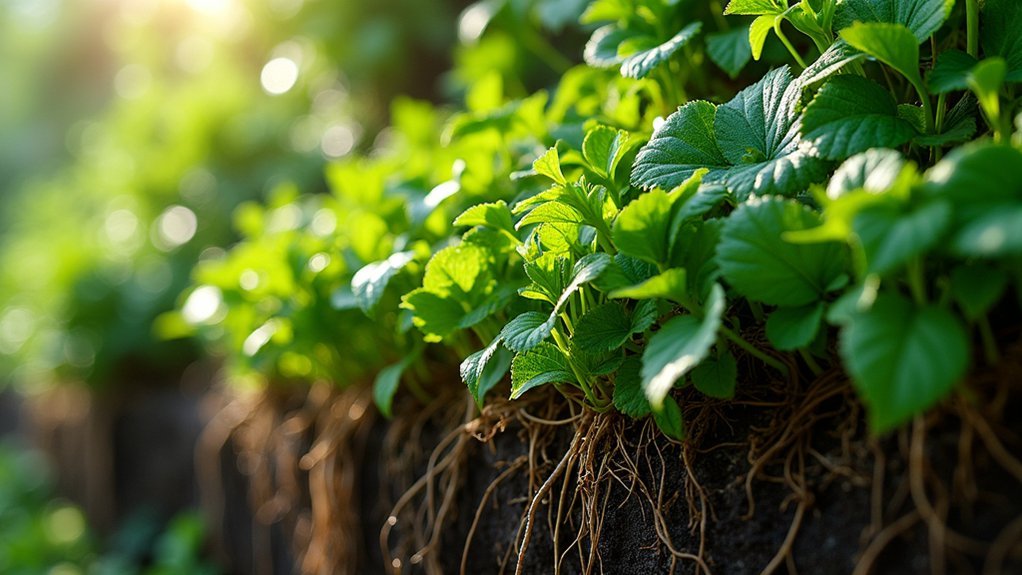
While water management remains critical in living wall systems, temperature control plays an equally essential role in ensuring root health and functionality. Your vertical installation’s root systems require proper temperature regulation to thrive, especially in warmer climates where excessive heat can hinder root development and nutrient absorption.
- Select climate-appropriate plants – Choose species naturally adapted to your environment that can withstand temperature fluctuations while maintaining robust root systems.
- Incorporate insulation materials – Add thermal barriers within your living wall structure to moderate temperature swings and create stable root zones.
- Monitor root zone temperatures – Regular checking prevents heat stress that could increase irrigation needs and reduce plant performance.
Modular Design Considerations for Root Expansion
When designing modular living wall systems, you’ll need to prioritize adequate space for root development to guarantee long-term plant success. Your modules should allow roots to penetrate at least 30 cm deep, preventing root binding and promoting healthy growth.
Choose lightweight growing media that balance moisture retention with proper aeration to enhance root development.
Don’t overlook the importance of drainage layers within your modular system—they’ll prevent waterlogging while ensuring roots receive adequate oxygen.
Smart plant selection is essential; consider species with root growth patterns that match your modular constraints. Some plants require considerably more space than others for ideal expansion.
Regularly inspect root health to catch issues like rot or nutrient deficiencies early. With thoughtful design and maintenance, your modular living wall will support robust, effective root systems.
Plant Selection Based on Root Characteristics
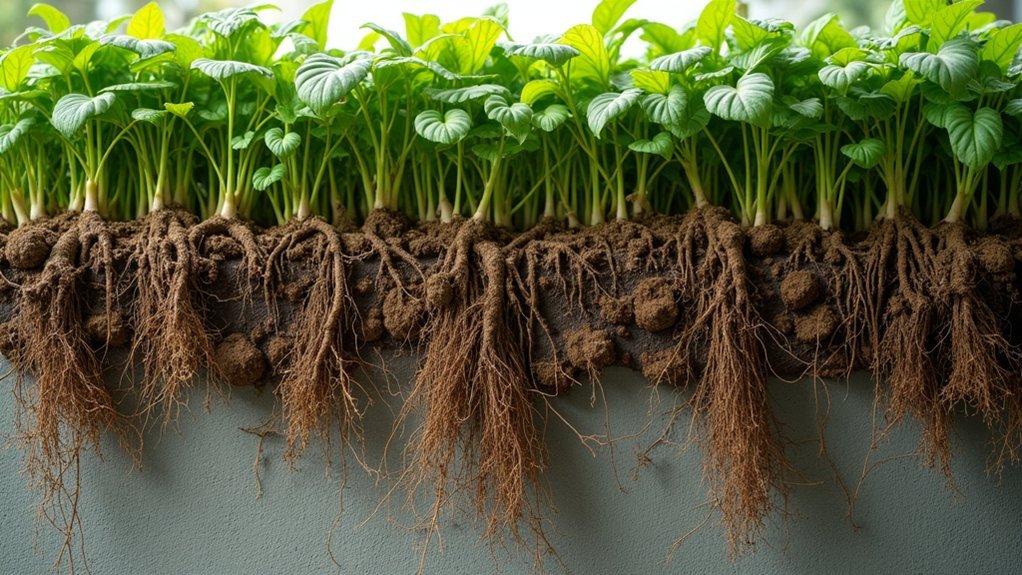
Selecting the right plants for your living wall depends critically on understanding their root characteristics.
When designing living wall systems, you’ll want to focus on species with lightweight, shallow root structures that won’t strain your installation or create maintenance headaches.
For ideal plant selection, consider these root characteristics:
- Size and spread – Choose succulents and cascading plants with compact root systems that thrive in limited soil volumes.
- Structure type – Prioritize plants with fibrous roots like certain ferns and grasses that enhance soil stability and prevent erosion.
- Resource efficiency – Select species whose root characteristics naturally improve moisture retention and nutrient uptake, leading to healthier vegetation overall.
Avoiding plants with aggressive, deep roots will prevent structural damage and guarantee your living wall remains stable and beautiful long-term.
Monitoring and Maintaining Root Health Over Time
Although often hidden from view, the root systems of your living wall require consistent attention to guarantee long-term success. Regular monitoring reveals vital indicators of root health—healthy roots should appear white and vigorous, signaling effective nutrient absorption.
Check moisture levels frequently to prevent both dehydration and root rot. You’ll find an automatic irrigation system invaluable for maintaining consistent hydration, reducing stress on roots and supporting healthier growth patterns.
Don’t overlook drainage analysis; excessive runoff leads to nutrient leaching while proper drainage enhances water retention and root development.
Include routine pruning in your maintenance schedule to reduce resource competition and create space for root expansion.
Balancing Aeration and Moisture for Root System Success
The success of your living wall depends critically on maintaining the delicate balance between aeration and moisture in your root systems. Roots need both oxygen to breathe and water to thrive, making this balance essential for healthy growth in fytotextile and other living wall systems.
To optimize your living wall’s root systems:
- Choose lightweight, well-draining substrates that enhance both aeration and moisture retention, creating ideal conditions for root expansion.
- Implement precise irrigation schedules to prevent overwatering (which suffocates roots) or underwatering (which causes root desiccation).
- Monitor soil moisture levels regularly, ensuring proper drainage to prevent stagnant water that leads to root rot and disease.
Advanced fytotextile systems with higher water retention capacity (up to 5.8 times greater) can greatly improve your wall’s root development while maintaining necessary oxygen levels.
Frequently Asked Questions
What Plants Are Best for a Living Wall?
For your living wall, you’ll want lightweight plants like ferns, sedums, and succulents. Choose drought-resistant varieties with shallow root systems. Mix different species that share similar water needs for easier maintenance.
What Kind of Soil Do You Use in a Living Wall?
You’ll want lightweight, soil-less mediums for your living wall. Use moisture-retaining materials like coconut coir or peat moss, enriched with slow-release fertilizers. Add perlite or vermiculite to improve drainage and maintain pH between 5.5-6.5.
How to Keep a Living Wall Alive?
To keep your living wall alive, you’ll need regular monitoring of irrigation, proper watering without overwatering, selecting appropriate plant species, pruning regularly, and implementing recirculating irrigation systems for ideal water management.
How Long Do Living Walls Last?
Your living wall can last 5-15 years, depending on your plant choices, maintenance routine, and system quality. If you invest in high-quality materials like Fytotextile and perform regular upkeep, you’ll maximize its lifespan.
In Summary
You’ll achieve lasting success with your living wall by focusing on root health. Confirm you’ve selected plants with appropriate root structures, provided balanced growing media, and implemented smart water management. Don’t forget to monitor root development regularly and make adjustments as needed. With proper attention to these foundational elements, your vertical garden will thrive for years to come.

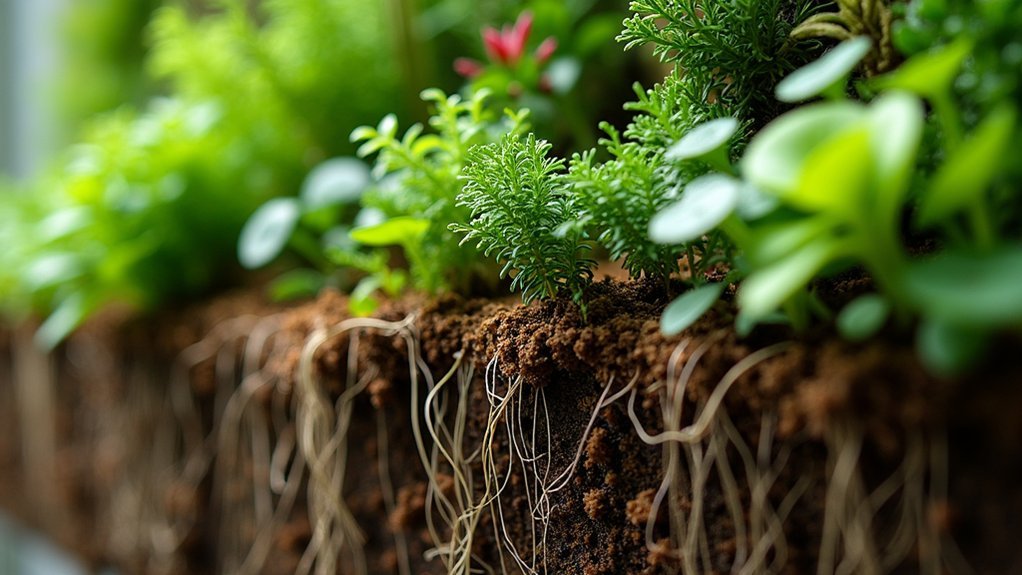



Leave a Reply